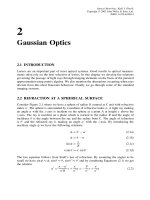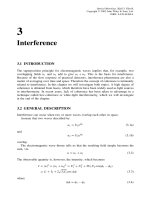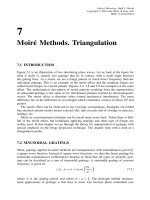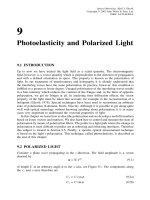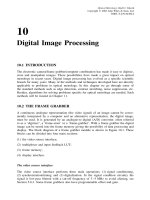Đo lường quang học P2
Bạn đang xem bản rút gọn của tài liệu. Xem và tải ngay bản đầy đủ của tài liệu tại đây (207.09 KB, 21 trang )
2
Gaussian Optics
2.1 INTRODUCTION
Lenses are an important part of most optical systems. Good results in optical measure-
ments often rely on the best selection of lenses. In this chapter we develop the relations
governing the passage of light rays through imaging elements on the basis of the paraxial
approximation using matrix algebra. We also mention the aberrations occurring when rays
deviate from this ideal Gaussian behaviour. Finally we go through some of the standard
imaging systems.
2.2 REFRACTION AT A SPHERICAL SURFACE
Consider Figure 2.1 where we have a sphere of radius R centred at C and with refractive
index n
. The sphere is surrounded by a medium of refractive index n. A light ray making
an angle α with the z-axis is incident on the sphere at a point A at height x above the
z-axis. The ray is incident on a plane which is normal to the radius R and the angle of
incidence θ is the angle between the ray and the radius from C. The angle of refraction
is θ
and the refracted ray is making an angle α
with the z-axis. By introducing the
auxiliary angle φ we have the following relations:
φ = θ
− α
(2.1a)
φ = θ − α (2.1b)
sin φ =
x
R
(2.1c)
n sin θ = n
sin θ
(2.1d)
The last equation follows from Snell’s law of refraction. By assuming the angles to be
small we have sin φ ≈ φ,sinθ ≈ θ,sinθ
≈ θ
and by combining Equations (2.1) we get
the relation
α
=
n − n
n
R
x +
n
n
α =−
P
n
x +
n
n
α(2.2)
Optical Metrology. Kjell J. G
˚
asvik
Copyright
2002 John Wiley & Sons, Ltd.
ISBN: 0-470-84300-4
16
GAUSSIAN OPTICS
q
a
V
n
n
′
f
C
z
R
q ′
a′
A
x
Figure 2.1 Refraction at a spherical interface
where
P =
n
− n
R
(2.3)
is called the power of the surface.
The spherical surface in Figure 2.1 might be the front surface of a spherical lens. In
tracing rays through optical systems it is important to maintain consistent sign conventions.
It is common to define ray angles as positive counterclockwise from the z-axis and
negative in the opposite direction. It is also common to define R as positive when the
vertex V of the surface is to the left of the centre C and negative when it is to the
right of C.
As can be realized, a ray is completely determined at any plane normal to the z-axis
by specifying x, its height above the z-axis in that plane, and its angle α relative to the
z-axis. A ray therefore can be specified by a column matrix
x
α
The two components of this matrix will be altered as the ray propagates through an
optical system. At the point A in Figure 2.1 the height is unaltered, and this fact can be
expressed as
x
= x(2.4)
The transformation at this point can therefore be expressed in matrix form as
x
α
= R
x
α
(2.5)
REFRACTION AT A SPHERICAL SURFACE
17
where
R =
10
−
P
n
n
n
(2.6)
is the refraction matrix for the surface.
At this point it is appropriate to point out the approximations involved in reaching this
formula. First, we have assumed the ray to lie in the xz-plane. To be general we should
have considered the ray to lie in an arbitrary plane, taken its components in the xz-and
yz-planes and introduced the component angles α and β relative to the z-axis. We then
would have found that x and α at a given point depend only on x and α at other points,
not on y and β. In other words, the pairs of variables (x, α) and (y, β) are decoupled from
one another and may be treated independently. This is true only within the assumption of
small angles. Because of this independence it is not necessary to perform calculations on
both projections simultaneously. We do the calculations on the projection in the xz-plane
and the answers will also apply for the yz-plane with the substitutions x → y and α → β.
The xz projections behave as though y and β were zero. Such rays, which lie in a single
plane containing the z-axis are called meridional rays.
In this theory we have assumed that an optical axis can be defined and that all light rays
and all normals to refracting or reflecting surfaces make small angles with the axis. Such
light rays are called paraxial rays. This first-order approximation was first formulated by
C. F. Gauss and is therefore often termed Gaussian optics.
After these remarks we proceed by considering the system in Figure 2.2 consisting of
two refracting surfaces with radii of curvature R
1
and R
2
separated by a distance D
12
.
The transformation at the first surface can be written as
x
1
α
1
= R
1
x
1
α
1
with R
1
=
10
−
P
1
n
1
n
1
n
1
(2.7)
where
P
1
=
n
1
− n
1
R
1
(2.8)
a
1
a′
1
a′
2
n
′
1
n
1
n
2
n
′
2
D
12
z
A
1
A
2
x
1
x
2
Figure 2.2 Ray tracing through a spherical lens
18
GAUSSIAN OPTICS
The translation from A
1
to A
2
is given by
x
2
= x
1
+ D
12
α
1
(2.9a)
α
2
= α
1
(2.9b)
which can be written in matrix form as
x
2
α
2
= T
12
x
1
α
1
with T
12
=
1 D
12
01
(2.10)
The refraction at A
2
is described by
x
2
α
2
= R
2
x
2
α
2
with R
2
=
10
−
P
2
n
2
n
2
n
2
(2.11)
where
P
2
=
n
2
− n
2
R
2
(2.12)
These equations may be combined to give the overall transformation from a point just to
the left of A
1
to a point just to the right of A
2
:
x
2
α
2
= M
12
x
1
α
1
with M
12
= R
2
T
12
R
1
(2.13)
This process can be repeated as often as necessary. The linear transformation between the
initial position and angle x, α and the final position and angle x
, α
can then be written
in the matrix form
x
α
= M
x
α
(2.14)
where M is the product of all the refraction and translation matrices written in order,
from right to left, in the same sequence followed by the light ray.
The determinant of M is the product of all the determinants of the refraction and
translation matrices. We see from Equation (2.10) that the determinant of a translation
matrix is always unity and from Equation (2.6) that the determinant of a refraction matrix
is given by the ratio of initial to final refractive indices. Thus the determinant of M is the
product of the determinants of the separate refraction matrices and takes the form
det M =
n
1
n
1
n
2
n
2
.... (2.15)
But n
1
= n
2
, n
2
= n
3
and so on, leaving us with
det M =
n
n
(2.16)
THE GENERAL IMAGE-FORMING SYSTEM
19
where n is the index of the medium to the left of the first refracting surface, and n
is the
index of the medium to the right of the last refracting surface.
2.2.1 Examples
(1) Simple lens. The matrix M is the same as M
12
in Equation (2.13). By performing the
matrix multiplication using n
1
= n
2
, n
1
= n, n
2
= n
and D
12
= d,weget
M =
1 −
P
1
d
n
2
nd
n
2
−
P
2
n
+
P
1
P
2
d
n
n
2
−
P
1
n
n
n
1 −
P
2
d
n
2
(2.17)
(2) Thin lens. A thin lens is a simple lens with a negligible thickness d.Ifweletd → 0
(i.e d R) in Equation (2.17) we obtain
M =
10
−
P
n
n
n
(2.18)
where the total power is given by (remember the sign convention for R)
P = P
1
+ P
2
=
n
2
− n
R
1
+
n
− n
2
R
2
(2.19)
Note that M has the same form for a thin lens as for a single refracting surface. Note
also that the matrix elements M
11
= 1andM
12
= 0. This means that we have x
= x,
independently of the value of α.
2.3 THE GENERAL IMAGE-FORMING SYSTEM
In a general image-forming system (possibly consisting of several lens elements) an
incoming ray at point B is outgoing from point B
, shown schematically in Figure 2.3.
The transformation matrix from B to B
is
M =
M
11
M
12
M
21
M
22
(2.20)
where the only requirement so far is
det M =
n
n
(2.21)
We now ask if it is possible to find new reference planes instead of B and B
for which
the general matrix M will take the form of that for a thin lens. These will turn out to
20
GAUSSIAN OPTICS
n
n
′
D
D
′
B
B′
H
H′
SYSTEM
Figure 2.3
be the so-called principal planes and intersect the axis at H and H
in Figure 2.3. The
transformation matrix from the H-plane to the H
-plane can be written in terms of M by
adding translation T and T
:
M
HH
= T
MT =
1 D
01
M
11
M
12
M
21
M
22
1 D
01
=
M
11
+ D
M
21
M
11
D + M
12
+ D
(M
21
D + M
22
)
M
21
M
21
D + M
22
(2.22)
The principal planes are defined as planes of unit magnification. Pairs of points in these
planes are images of each other and planes with this property are called conjugate planes.
Because of this requirement, the 1, 1 element of M
HH
must be unity and the 1, 2 element
must be zero, giving
M
HH
=
10
M
21
n
n
(2.23)
We now equate the elements of the matrices in Equation (2.22) and (2.23)
11 : M
11
+ D
M
21
= 1i.e.D
=
1 − M
11
M
21
(2.24a)
22 : M
21
D + M
22
=
n
n
i.e. D =
(n/n
) − M
22
M
21
(2.24b)
These equations are meaningful only if the condition
M
21
= 0 (2.25)
is satisfied. This then becomes the requirement that our general Gaussian system be image-
forming. (Identification of matrix element 12 gives the same condition.) To complete the
final equivalence between our general image-forming system and a thin lens, it is only
necessary to make the identification
THE IMAGE-FORMATION PROCESS
21
−
P
n
= M
21
(2.26)
Thus the image-formation condition, Equation (2.25) guarantees that our system has non-
zero power. This means that all image forming systems have the same formal behaviour
in Gaussian optics, as far as ray-tracing is concerned. It should be noted that for an afocal
system like the plane wave set-up in Figure 1.14 where the two focal points coincide,
M
21
= 0. This is the same configuration as in a telescope where we only have angular
magnification.
2.4 THE IMAGE-FORMATION PROCESS
We now want to move from the principal planes to other conjugate planes and determine
the object-image relationships that result. This is done by translation transformations over
the distances a and b in Figure 2.4. The overall transformation matrix from A to A
is
given by
M
AA
=
1 b
01
10
−
P
n
n
n
1 a
01
=
1 −
bP
n
a −
abP
n
+
nb
n
−
P
n
−
aP
n
+
n
n
(2.27)
The image-formation condition is that the 1, 2 element of this matrix be zero:
a −
abP
n
+
nb
n
= 0 (2.28)
that is
n
a
+
n
b
= P(2.29)
A
HH′
A′
ab
Figure 2.4
22
GAUSSIAN OPTICS
When the image is at +∞, the object is in the first focal plane at a distance
a =
n
P
≡ f(2.30)
to the left of the first principal plane. When the object is at +∞, the image is in the
second focal plane at a distance
b =
n
P
≡ f
(2.31)
to the right of the second principal plane. Thus Equation (2.29) may be written in the
Gaussian form
n
a
+
n
b
=
n
f
=
n
f
(2.32)
When the refractive indices in image and object space are the same (n = n
), this equation
takes on the well known form
1
a
+
1
b
=
1
f
(2.33)
i.e. the lens formula.
When we have image formation, our matrix can be written
M
AA
=
m
x
0
−
P
n
m
α
(2.34)
where the lateral magnification is
m
x
= 1 −
bP
n
= 1 −
b
f
=−
nb
n
a
(2.35)
and the ray angle magnification is
m
α
=−
aP
n
+
n
n
=−
a
b
(2.36)
From the condition det M
AA
= n/n
we obtain the result
m
x
m
α
=
n
n
(2.37)
In addition to the lateral (or transversal) magnification m
x
, one might introduce a longi-
tudinal (or axial) magnification defined as b/a. By differentiating the lens formula,
we get −a/a
2
− b/b
2
= 0, which gives
b
a
=−
b
a
2
=−m
2
x
(2.38)

